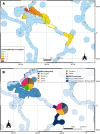Habitat-use of the vulnerable Atlantic Nurse Shark: a review
- PMID: 37337585
- PMCID: PMC10276984
- DOI: 10.7717/peerj.15540
Habitat-use of the vulnerable Atlantic Nurse Shark: a review
Abstract
Human activities have led to the loss of critical habitats for aquatic species at such an accelerated rate that habitat modification is considered a leading threat to biodiversity. Sharks and rays are considered the second most threatened group of vertebrates that have also suffered from habitat loss, especially in nursery grounds and reef-associated species. In this sense, actions toward the conservation of critical grounds for species survival are urgently needed, especially for those threatened with extinction. This study aimed to gather and provide information on the worldwide distribution and habitat association of the 'vulnerable' Atlantic Nurse Shark Ginglymostoma cirratum through a literature review performed at the Dimensions research database. A total of 30 studies published between 1950 and 2021 were retained since they defined at least the type of habitat in which G. cirratum was associated. Most studies covered the Floridian ecoregion, where G. cirratum is more common and abundant. Reefs, seagrass, sandy, rocky, mangrove, and macroalgae accounted for the majority of habitat associations, with a higher diversity of habitats detected within marine protected areas (MPAs). Ginglymostoma cirratum was recorded at a maximum depth of 75 m, temperatures ranging from 25 °C to 34 °C, and salinities between 31 and 38 ppt. Neonates were associated with shallower habitats (<20 m), mostly reefs, rocks, macroalgae, sandy shores, and seagrass, in an average temperature of 26 °C and salinity of 36 ppt. Breeding events and habitats were reported by 11 studies, 72.7% of them in shallow waters, mostly inside MPAs (90.9%). Our findings highlighted the key role played by MPAs in protecting essential grounds for threatened species, such as the Atlantic Nurse Shark. Major ecoregions (e.g., the Eastern Atlantic) are still underrepresented in the scientific literature as long as studies aim specifically to assess G. cirratum habitat association. Thus, further insights into the essential habitats needed to conserve the Atlantic Nurse Shark can still emerge from future studies. Considering the recent IUCN extinction risk status change in G. cirratum (i.e., Data Deficient to 'Vulnerable'), new conservation measures that integrate habitat protection and management are urgently needed and should consider the data collected herein.
Keywords: Conservation; Ecosystem; Habitat association; Marine protected areas.
© 2023 Bettcher et al.
Conflict of interest statement
The authors have no conflicts of interest to declare.
Figures





Similar articles
-
Hydroids (Cnidaria, Hydrozoa) from Mauritanian Coral Mounds.Zootaxa. 2020 Nov 16;4878(3):zootaxa.4878.3.2. doi: 10.11646/zootaxa.4878.3.2. Zootaxa. 2020. PMID: 33311142
-
Retrieving records of a rare and threatened shark in a mosaic of marine-protected areas of southeastern Brazil.J Fish Biol. 2023 May;102(5):1256-1260. doi: 10.1111/jfb.15357. Epub 2023 Mar 13. J Fish Biol. 2023. PMID: 36820469
-
Defining distribution and habitat use of west-central Florida's coastal sharks through a research and education program.Ecol Evol. 2021 Oct 26;11(22):16055-16069. doi: 10.1002/ece3.8277. eCollection 2021 Nov. Ecol Evol. 2021. PMID: 34824811 Free PMC article.
-
The functional value of Caribbean coral reef, seagrass and mangrove habitats to ecosystem processes.Adv Mar Biol. 2006;50:57-189. doi: 10.1016/S0065-2881(05)50002-6. Adv Mar Biol. 2006. PMID: 16782451 Review.
-
Sieving a living: a review of the biology, ecology and conservation status of the plankton-feeding basking shark Cetorhinus maximus.Adv Mar Biol. 2008;54:171-220. doi: 10.1016/S0065-2881(08)00003-5. Adv Mar Biol. 2008. PMID: 18929065 Review.
References
-
- Adams DH, Paperno R. Preliminary assessment of a nearshore nursery ground for the scalloped hammerhead off the Atlantic Coast of Florida. American Fishery Society Symposium. 2007;50:165–174.
-
- Afonso AS, Cantareli CV, Levy RP, Veras LB. Evasive mating behaviour by female nurse sharks, Ginglymostoma cirratum (Bonnaterre, 1788), in an equatorial insular breeding ground. Neotropical Ichthyology. 2016;14(4):179. doi: 10.1590/1982-0224-20160103. - DOI
-
- Airoldi L, Balata D, Beck MW. The gray zone: relationships between habitat loss and marine diversity and their applications in conservation. Journal of Experimental Marine Biology and Ecology. 2008;366(1–2):8–15. doi: 10.1016/j.jembe.2008.07.034. - DOI
-
- Albano PS, Fallows C, Fallows M, Schuitema O, Bernard ATF, Sedgwick O, Hammerschlag N. Successful parks for sharks: no-take marine reserve provides conservation benefits to endemic and threatened sharks off South Africa. Biological Conservation. 2021;261(February):109302. doi: 10.1016/j.biocon.2021.109302. - DOI
Publication types
MeSH terms
LinkOut - more resources
Full Text Sources

